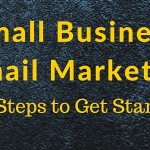
The days of running out to the mailbox for circulars and fliers are long gone. The average person receives 121 emails per day and that number is expected to rise in the future. It is likely that the elephant in the room with your small business marketing plan has been the sometimes dreaded, but necessary, email marketing campaign.
Small business email marketing is a key element for business success in the digital age, but the process does not have to be expensive or scary.
If you have only dabbled in email marketing or have not done any email marketing previously for your business it is time for a change. To get started with your small business email marketing efforts TODAY, follow these five simple steps and you will be well on your way:
Step 1: Choose an Email Service Provider
Having an effective way to send email campaigns, grow your email lists and measure your email marketing success is an essential step. Although you may be familiar with spreadsheets and may already have a list of email contacts organized in Excel, it is not recommended that your small business manage the process of email marketing internally.
Several reputable providers are available that work very hard to ensure that your emails are well structured, not blocked by ISPs, and that you have all of the needed tools to be successful. And, the best part is that many of the services start out with no fees. As you grow your email lists or need more advanced features, fees will apply, but not when your business is starting out.
Here are a few of the more popular and user friendly email marketing services. there are many others.
- MailChimp – More than 10 million users benefit from MailChimp. Their easy to use templates, automation features, and advanced analytics make them a great choice for many small businesses. MailChimp is free if your email list is under 2000 subscribers.
- AWeber – Known for seamless integration with many blog and eCommerce sites, AWeber offers a one month free trial and then starts their pricing at $19/month.
- Constant Contact – Drag and drop templates, easily shareable formats, and analytics make Constant Contact a popular choice. They offer a 60 day free trial and then begin pricing at $20/month.
Quick Tip: Spend some time to explore which service provider will best meet your business needs. Carefully considering this step will translate into future success of your small business online presence.
Step 2: Build and Grow Your Email List
You have selected a provider and maybe even played around with some email templates, but, who are you planning to send your emails to? If you currently have a spreadsheet with customer email addresses, the email providers listed above allow them to be uploaded from the spreadsheet to the provider platform with ease.

Once you have your current email list base ready to go, how can a small business continue to grow their list? There are many different ways to grow a list. Some of them will depend on your business category and your specific products or services. Here are some suggestions to get you started.
- Add a subscriber box to your website for visitors to easily sign up.
- Encourage current customers, friends, family, employees to share your email list sign up link.
- Promote an online contest and require a verified email address to enter.
- Add a “Call to Action” button at the top of your Facebook business page.
- Add a QR code to print marketing to collect email addresses.
Quick Tip: Each email address captured has tremendous value to your small business once you begin to develop high quality email campaigns. It is important to always have permission to use an email address. Without the email recipient’s permission, you run the risk of losing provider privileges due to sending spam.
Step 3: Develop a Small Business Email Marketing Strategy
Depending on your small business model, the purpose of small business email marketing could be to disseminate information, promote sales, encourage support, or any number of other objectives.
Defining your business’ specific objectives and developing an appropriate strategy is imperative to success. Ask the following questions when developing a clear email marketing strategy:
- What are the objectives of each campaign? Identifying how you are providing value and what actions you want your subscribers to take is important. This can vary from campaign to campaign and between mailing lists or list segments.
User actions could include consuming the content you provide, sharing content, buying, or responding in other ways to your call to action. Be clear about the action and purpose of each campaign in order to gain real results.
- Who is my demographic? What are the characteristics of the people you want to reach via email? If your email campaigns will include a variety of information that may not apply to all of your subscribers it is important to segment your email list.
Segmenting will ensure that subscribers only receive information that they want and that is relevant to them. This will result in higher open rates for your email campaigns and more effective engagement with subscribers.
- Email Frequency – How often does my audience want to hear from my business? Depending on the business type, finding the right frequency of emailing will differ. Understanding your business and following a few guidelines for frequency will improve email retention rates and the effectiveness of the campaign.
Many times, small businesses find that engaging their entire audience on a monthly basis with a newsletter is effective and creates a customer expectation. Following up with different segments through use of quick and to the point email notes throughout the month builds branding.
Quick Tip: Sending campaigns that only focus on “buy, buy, buy” is a quick way drive people to unsubscribe from your list or to just delete your emails without opening them. Instead focus on how your email communications provide value to your subscribers.
Step 4: Create High Quality Content
Crafting an effective, high quality, engaging marketing email is a task that takes time and thought. Sure, you can throw a quick “blast” together promoting your latest product and get it in the queue, but you will quickly notice a growing number of subscribers are unsubscribing and that your business objectives are not being met. Consider the following prior to hitting send:
- Create email campaigns that have a clear purpose.
- Get to know your readers and engage with your subscribers.
- Create valuable content to send to your subscribers.
Creating the content should be the most time consuming task of email marketing for small business. Keep the salesy language to a minimum and engage with your customers on an emotional level in order to encourage future business and brand confidence.
Step 5: Use Analytics to Measure and Improve
All of the providers mentioned above offer some form of analytics for measuring the performance of your email marketing campaigns. Most service providers also allow businesses to link to their Google Analytics accounts for more detailed analysis.
Just because you think that your email was amazing, does not mean that your customers receive it well or act according to your master plan. It is important to create reports that carefully consider whether objectives and calls to action are being realized and modify future campaign to improve results.
Conclusion:
Email is a powerful business marketing tool. It also provides the opportunity to start small without a major investment. Utilize the five steps described above to develop and launch your initial small business email marketing campaigns.
By investing some time and planning at the beginning of this process you will be on your way to improving your small business web presence and growing your customer base. As your email lists and email expertise grow you will soon become a savvy small business email marketing champion.
Here are some others Posts you may enjoy:
9 Benefits of Email Marketing for Small Business

